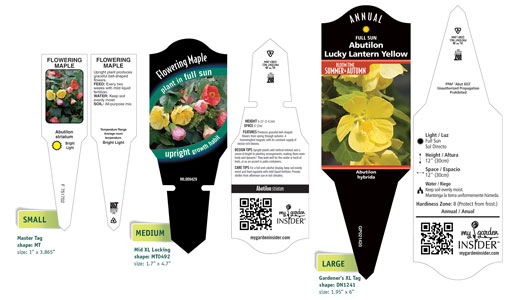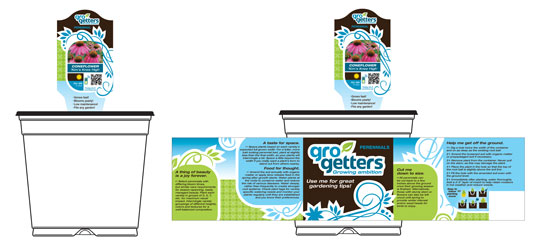2/27/2013
The Hows & Whys of Plant Tags: Part 2
Gerry Giorgio
I’m always rounding up or down on my tag order. Why can’t I buy the exact quantity of tags I need?
Most tags, at least from your major vendors, are printed in what is called offset lithography. These are typically high-volume printers that run either a sheet or roll of substrate (plastic, paper, etc.) through a printing press. The substrate has a finite dimension. Depending on the size, a given amount of tags can be printed onto each sheet or roll. The smaller the tag, the more you can print; the larger the tag, the fewer you can print. But the substrate remains a constant size.
Think of it this way: In a 1020 flat, you might get 32, 48 or 72 plants in a flat. If ordering a 48 count, you have to order in the flat increments. You can’t order 49 or 50. You would have to order either 48 or 96. The need to round up or down is obvious. It’s a similar situation with tags.
What is the most significant thing I can do to improve my plant care tags?
In the broadest sense, put yourself in the shoes of the average gardener. This is sometimes difficult to do for those who have spent years, decades or their entire life marinating in horticulture. So, you have to play a little trick on your mind. Actually, you need to be reflective of your own experiences, good and bad, with information communicated to you on consumer products outside your industry.
Have you ever been frustrated with instructions provided with a product you bought? What was that like? Did you curse the so-and-sos on why they couldn’t make this a little easier? Well, you don’t want to be on the receiving end of a gardener looking at your product with the same frustration. Printed information delivered to you at the point of decision needs to be clear and informative. It should help you make a good decision. Consider the package with font that is too small to read or the menu with fancy font that you can’t see either. How about the last time you bought an electronic gadget that seemed so complex you wanted to throw it back in the box. Probably written by techno geeks who think everyone knows what they know. So, don’t be a “techno plant geek” either!
Okay—So, let’s say I agree to put more information, images and icons that gardeners are asking for. How do I do that given the size of a plant tag?
This is a good question. There is only so much real estate on a tag. Of course, tags come in all sizes. Let’s look at the options.
 Move to a larger tag.
Move to a larger tag. (Figure 1) This may seem obvious, but the best solution here is a larger tag with a more prudent application to what is actually being put on it. I understand that cost is a factor. And I know what you’re thinking, “Sure, a larger tag is exactly what the ‘tag guy’ wants me to buy!” I understand how you feel and I don’t dismiss or take lightly the input costs of growers and retailers. I just ask that you trust me on this from looking at thousands of different styles of tags. It’s a simple matter of what you need to communicate with the garden shopper. The test is to compare your plant product to other consumer product labeling. How does your product stand up?
Add a printed pot to go along with the tag. (Figure 2) Here’s an opportunity to expand your information beyond the tag. Printed pots can hold graphics and text. Print minimums can be high per unique pot, so this is likely an option for large growers, but one that’s underutilized. Does it add cost? Yes, but we’re talking about adding true value to your finished product as well.

Add a pressure-sensitive sticker to the pot. Again, not in place of the tag, but as an opportunity to include more information that gardeners are requesting. Consider the tag to carry the point of sale information and the pot as what will be accessed at home when planting.
Buy yourself more room on annual tags. What I mean here is that annuals are sold in color, right? And herbs have no color and are sold for their foliage. These are two conditions in which you can try eliminating the photo, as the plants present themselves. A photo is redundant. This could free up from 30% to 50% of the tag real estate for additional information. I know this bucks tradition—I’m just sayin’ think about it!
Why is there so much discrepancy between the care text on a tag and the actual performance of the plant?
Typically, plant care text is sourced from a universal and recognized publication of information defining the average range of garden performance for a given plant. For example, the American Horticultural Society Encyclopedia of Plants and Flowers would be such a reference, as well as the USDA Hardiness Zone Map. Both of these publications are used when creating care text for a plant tag. The differences come in the variables of regional or microclimate area where plant performance may vary significantly. Local and regional reference material is available for these areas as well.
So, if tag companies know there’s a difference in regional or microclimate plant performance and there are references that can be used, why stick to just one point of reference? Why not make tags that are appropriate for a specific region?
Yes, this does seem like an obvious solution, doesn’t it? Especially true in an era of massive amounts of information. The challenge would be when providing stock tags to a national or even international marketplace, the balance of print production efficiencies and the risks of excess inventory must be considered. However, regional or microclimate information can be printed on a horticultural plant care tag when requesting a custom tag. This is really the best solution if very specific and local garden performance information must be communicated to your customers.
Next month, I’ll take a stab at answering questions about tags, signs and their place in an effectively merchandised display. We’ll explore the benefits and detractors of setting a retail store and offer solutions to provoke some thought around this topic.
GT
 Gerry Giorgio is an artist, urban gardener and the Marketing Manager at MasterTag—a horticultural printing company.
Gerry Giorgio is an artist, urban gardener and the Marketing Manager at MasterTag—a horticultural printing company.